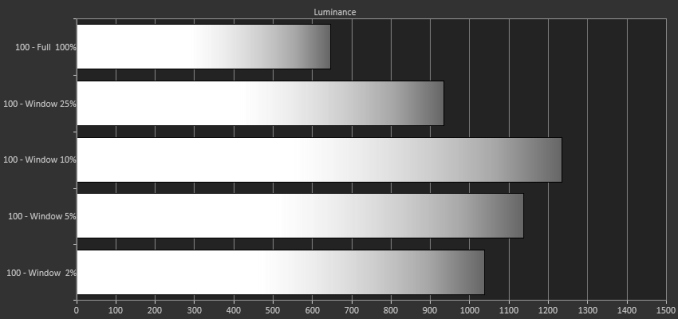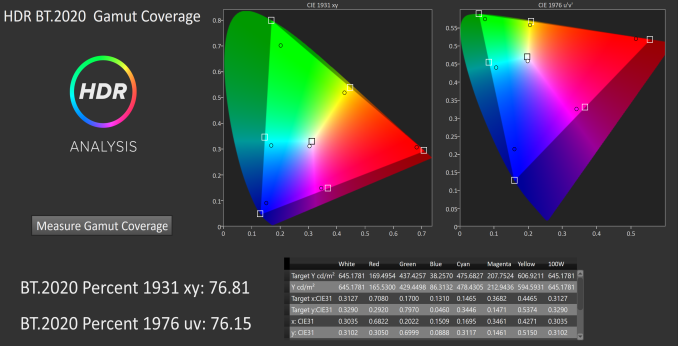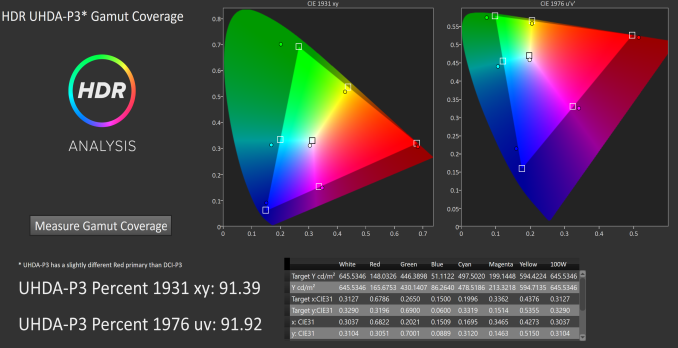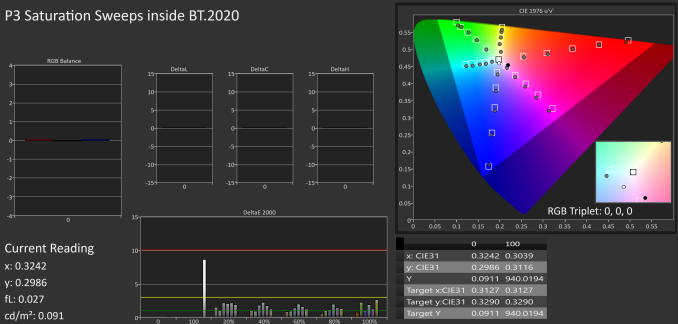The Asus ROG Swift PG27UQ G-SYNC HDR Monitor Review: Gaming With All The Bells and Whistles
by Nate Oh on October 2, 2018 10:00 AM EST- Posted in
- Monitors
- Displays
- Asus
- NVIDIA
- G-Sync
- PG27UQ
- ROG Swift PG27UQ
- G-Sync HDR
HDR Color And Luminance
New to our monitor workflow, we've utilized some of CalMAN's recent HDR Analysis workflow additions, again in the SpectraCal suite. As I don't have an HDR test pattern generator currently, we've utilized madTPG for the HDR pattern generator. To note, in SDR mode the monitor reports a "SDR-BT1886" EOTF (gamma) instead of "SDR-sRGB" when in YCbCr mode, but in HDR mode the EOTF is "HDR-ST2084".
Checking back on HDR brightness, we see that the peak brightness is around 1236 nits, reached when a 10% area of the screen was white. So there's definitely room to spare with respect to the 1000 nit minimum requirement.
The HDR gamut coverage matches what we saw with the SDR 'wide gamut' mode, confirming that it covers around 76% BT.2020 and 92% DCI-P3.
Originally in delta ICtCp format, which reportedly describes HDR more accurately, the metrics are in delta E for ease of comparison. The HDR10 media profile targets the BT.2020 space, so it's important to see how well devices designed for the more limited P3 gamut do inside this subset. In that respect the PG27UQ is able to do quite well, with dE's below 3 on color saturation sweeps.
As for chroma subsampling, the 4:2:2 mode kicks into effect when in HDR mode at 120Hz or above. The lack of full horizontal color data can be noticed in certain cases, such as colored text on colored backgrounds where font can become blurry.

















91 Comments
View All Comments
lilkwarrior - Monday, October 8, 2018 - link
OLED isn't covered by VESA HDR standards; it's far superior picture quality & contrast.QLED cannot compete with OLED at all in such things. I would very much get a Dolby Vision OLED monitor than a LED monitor with a HDR 1000 rating.
Lolimaster - Tuesday, October 2, 2018 - link
You can't even call HDR with a pathetic low contrast IPS.resiroth - Monday, October 8, 2018 - link
Peak luminance levels are overblown because they’re easily quantifiable. In reality, if you’ve ever seen a recent LG TV which can hit about 900 nits peak that is too much. https://www.rtings.com/tv/reviews/lg/c8It’s actually almost painful.
That said I agree oled is the way to go. I wasn’t impressed by any LCD (FALD or not) personally. It doesn’t matter how bright the display gets if it can’t highlight stars on a night sky etc. without significant blooming.
Even 1000 bits is too much for me. The idea of 4000 is absurd. Yes, sunlight is way brighter, but we don’t frequently change scenes from night time to day like television shows do. It’s extremely jarring. Unless you like the feeling of being woken up repeatedly in the middle of the night by a flood light. It’s a hard pass.
Hxx - Saturday, October 6, 2018 - link
the only competition is Acer which costs the same. If you want Gsync you have to pony up otherwise yeah there are much cheaper alternatives.Hixbot - Tuesday, October 2, 2018 - link
Careful with this one, the "whistles" in the article title is referring to the built-in fan whine. Seriously, look at the newegg reviews.JoeyJoJo123 - Tuesday, October 2, 2018 - link
"because I know"I wouldn't be so sure. Not for Gsync, at least. AU Optronics is the only panel producer for monitor sized displays that even gives a flip about pushing lots of high refresh rate options on the market. A 2560x1440 144hz monitor 3 years ago still costs just as much today (if not more, due to upcoming China-to-US import tariffs, starting with 10% on October 1st 2018, and another 15% (total 25%) in January 1st 2019.
High refresh rate GSync isn't set to come down anytime soon, not as long as Nvidia has a stranglehold on GPU market and not as long as AU Optronics is the only panel manufacturer that cares about high refresh rate PC monitor displays.
lilkwarrior - Monday, October 8, 2018 - link
Japan Display plans to change that in 2019. IIRC Asus is planning to use their displays for a portable Professional OLED monitor.I would not be surprised they or LG created OLED gaming monitors from Japan Display that's a win-win for gamers, Japan Display, & monitor manufacturers in 2020.
Alternatively they surprise us with MLED monitors that Japan Display also invested in + Samsung & LG.
That's way better to me than any Nano-IPS/QLED monitor. They simply cannot compete.
Impulses - Tuesday, October 2, 2018 - link
I would GLADLY pay the premium over the $600-1,000 alternatives IF I thought I was really going to take advantage of what the display offers in the next 2 or even 4 years... But that's the issue. I'm trying to move away from SLI/CF (2x R9 290 atm, about to purchase some sort of 2080), not force myself back into it.You're gonna need SLI RTX 2080s (Ti or not) to really eke out frame rates fast enough for the refresh rate to matter at 4K, chances are it'll be the same with the next gen of cards unless AMD pulls a rabbit out of a hat and quickly gets a lot more competitive. That's 2-3 years easy where SLI would be a requirement.
HDR support seems to be just as much of a mess... I'll probably just end up with a 32" 4K display (because I'm yearning for something larger than my single 16:10 24" and that approaches the 3x 24" setup I've used at times)... But if I wanted to try a fast refresh rate display I'd just plop down a 27" 1440p 165Hz next to it.
Nate's conclusion is exactly the mental calculus I've been doing, those two displays are still less money than one of these and probably more useful in the long run as secondary displays or hand me down options... As awesome as these G-Sync HDR displays may be, the vendor lock in around G-Sync and active cooling makes em seem like poor investments.
Good displays should last 5+ years easy IMO, I'm not sure these would still be the best solution in 3 years.
Icehawk - Wednesday, October 3, 2018 - link
Grab yourself an inexpensive 32" 4k display, decent ones are ~$400 these days. I have an LG and it's great all around (I'm a gamer btw), it's not quite high end but it's not a low end display either - it compares pretty favorably to my Dell 27" 2k monitor. I just couldn't see bothering with HDR or any of that other $$$ BS at this point, plus I'm not particularly bothered by screen tearing and I don't demand 100+ FPS from games. Not sure why people are all in a tizzy about super high FPS, as long as the game runs smoothly I am happy.WasHopingForAnHonestReview - Saturday, October 6, 2018 - link
You dont belong here, plebian.